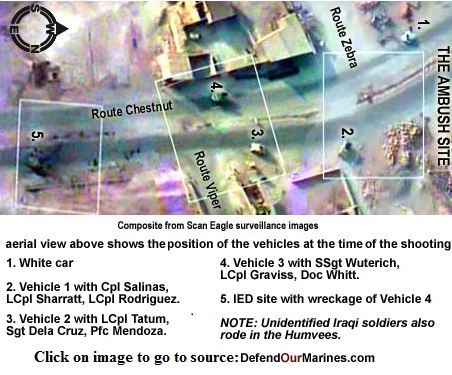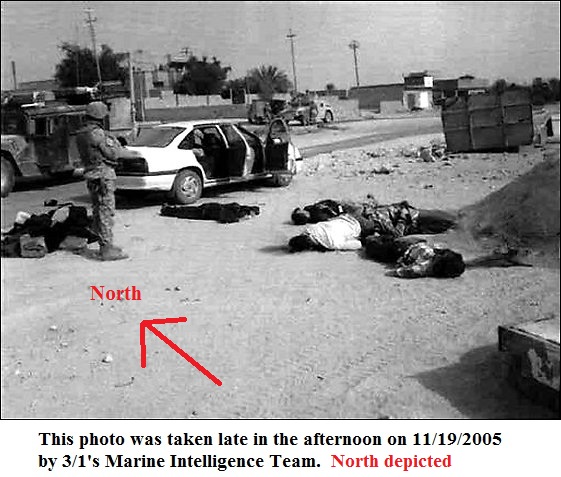United States Marine Staff Sergeant Frank Wuterich stands accused of 9 counts of voluntary manslaughter, 2 counts of assault with a dangerous weapon, 3 counts of dereliction of duty, and “responsible for the deaths of 19 civilians” in Haditha, Iraq. The trial is expected to take four weeks. The prosecution began its case last Monday. If you have not, please first read Part I. Part II completes my analysis of the trial to date and includes key testimony that the media has failed to report. Part II begins immediately after SSgt Wuterich has eliminated the threat posed by five military-aged men moving near a white car across the road from the lead Humvee in his resupply convoy. [Updated January 20, 2012]
Approximately 200 feet behind Wuterich, a buried IED had been set off. The driver of the 4th Humvee was dead and two more lay wounded. From about 75 ft away, Wuterich had eliminated by fire the threat posed by five military-aged men near a white car. He turned, went to the 3rd Humvee, radioed-in HQs a situation update, and then went to his wounded Marines. “Doc” Whitt, Tatum, and Salinas preceded him, while under enemy fire, in reaching the stricken vehicle.
Salinas testified Thursday he exchanged fire with a man to his south on the side of house #1:
“Rounds were impacting on the fourth vehicle. I went back to render aid to my Marines that were wounded. There was destruction everywhere. There was a fog, a haze. When the smoke was clearing out I could see an object. It was LCpl Crossan. He was missing a couple of fingers. His body armor was obstructing his airway … “I got as low as I could because I heard rounds coming. It was the impact of the rounds hitting the high back. I got low on the deck,” he said.
…
Salinas described an ugly, bitter war, a no-quarter environment where innocent victims found themselves on November 19, 2005. Al Anbar Province lived [what] was a waste land after two bloody years of internecine warfare.“On the outside of the house, on the east side of the house, I saw a small silhouette. Things look small that far away. It was a tall man. There was rounds impacting around me, so I engaged him. I used my M-16. I shot more than twice but not the entire magazine,” he told prosecutor Lt Col Sean Sullivan. “Then I took my 203 (M-203 40mm grenade launcher attached underneath his rifle) and fired rounds on the house — fired two or three.” It was while trying to find Crossan’s fingers, he explained.
LT William Kallop was Wuterich’s platoon leader and led the quick reaction force to Route Chestnut in Haditha. Kallop testified Friday that:
“…he believed the ambush was the beginning of the long anticipated counterattack by insurgents who had infiltrated into the city. … Wuterich gave him a brief report. After making sure the squad leader of the Quick Reaction Force began evacuating the two wounded Marines still lying on the road, he gave Wuterich the order to “clear South” to suppress incoming fire the ambushed Marines had observed coming from what later became known as House 1 and 2.”
The Los Angeles Times reported Saturday:
“[Kallop] believed insurgents inside the house were firing on Marines and thus the house could be deemed “hostile.” … A Marine lawyer, testifying after Kallop, gave a different interpretation of the rules of engagement. Maj. Kathryn Navin, who had lectured Marines before they deployed, said a house cannot be declared hostile unless the people inside are known to have “hostile intent” or have committed “hostile acts.” But Kallop said that in training at Camp Pendleton and March Reserve Air Base, and at briefings delivered in Iraq, Marines were not told they needed to identify individual targets as threatening when assaulting a “hostile” structure.
What the Times did not report was Major Navin had previously testified a house “could be declared ‘hostile.'” That fact came out during cross-examination when Navin was asked to read a transcript of her own testimony from August 2007, according to trial observer Heidi (Hamilton) Anselmo who I spoke with by phone last night. When asked by defense counsel to explain her previous testimony, Navin offered, “Maybe I got mixed up.”
President Barack Obama, former President George W. Bush, and literally hundreds of U.S. military officers would be facing prosecution if [Major Navin’s interpretations of] the Marine Corps’ ROE applied to them; they have ordered airstrikes upon houses without first personally identifying that everyone within them had “hostile intent” or had committed “hostile acts.” While at the ambush site, Kallop received reports from Wuterich and other Marines of enemy fire coming from house #1. Salinas had marked it as a target with M203 grenades. It was then clear to Kallop, Wuterich, and Salinas the enemy was using the house for military purposes and eliminating the threat posed to their Marines was necessary self-defense (See the ROE card they carried.)
Intelligence officer Major Don Dinsmore will testify today at the trial. He fought what is known as the ‘intelligence battle’ for 3/1 that day in Haditha, recorded in real time the enemy’s positions and activities, assessed the information, and sent a stream of intelligence to the Marines on the ground. Each of Kilo Company’s four platoons fought battles within a half-mile of the initial IED blast. Before you read media reports after Dinsmore testifies, perhaps you should first read Nat Helm’s report about his July 2007 interview of Cpl Joe Haman. His squad was manning a combat observation post that morning 600 meters south of the IED-initiated ambush. Including Haman, 7 Marines and a Navy Corpsman were wounded during a “grenade throwing contest” with insurgents later that morning:
“Somebody said his [Terrazas] number, but we didn’t know who it was. We just knew somebody had been killed or wounded,” Haman said. … About 30 minutes before Haman’s squad was called into action … Then a nearby helicopter reported to headquarters that a large group of insurgents were fleeing out the back of the small cluster of houses now under counter-attack by Wuterich’s squad. The pilot spotted the insurgents when they abandoned the houses where the civilians died, Haman said.”
During his first combat action, Wuterich led three combat veterans of the 2nd Battle of Falluja in a combat assault upon house 1 and 2 to eliminate the threat. The Haditha massacre of innocent civilians was designed by lesser men; justice needs brought to them for that war crime. In Haditha, honorable Marines fought as they were trained. The enemy is solely to blame for every death that occurred that day; Al Qaeda and Sunni insurgents hid among and initiated fights behind defenseless women, children, and old men.
Regardless of anyone’s opinion about the need to invade Iraq, America owed Frank Wuterich far better than a court-martial. [He led] Marines caught within an ambush in a series of counter-attacks to defeat the enemy while complying the best he could with ambiguous Rules of Engagement.
SSgt Wuterich lived up to his enlistment oath to “obey the orders of the President of the United States and the orders of the officers appointed over” him, at dire risk to his own life. America sends its sons and daughters to war to fight, win, and survive, not on suicide missions. They bravely fight counter-insurgent warfare on our behalf and must live with haunting memories of collateral damages. The criminalization of our warriors must end.


